How to Optimize Your Website For Better SEO
Having a fully optimized website helps to provide excellent user experience, which translates to conversions and improves organic search engine rankings. In this blog post, we will explain some of the ways to optimize your webpages and improve the search engine rankings of your small business website.
The small business website SEO checklist
-
- Research keywords and phrases
- Optimize title tag, meta description, and URL
- Optimize heading tags (h1, h2, h3, h4, h5, h6)
- Optimize images (size and name)
- Add structured data (Schema)
- Add links (internal and external)
As an example, we will be using a real, local lawn care company that we helped designing, developing, and optimizing their website. Not to brag, but they rank the first page on several cities for their service areas.
#1 Research Keywords
Research and planning play an essential role in the success of your on-page webpage optimization process. In order to make informed decisions, we need to research the most used terms and keywords related to the contents of your webpage.
For example, the company Home and Garden provides lawn care services in the southwest suburbs of Chicago like Joliet, Plainfield, Naperville, and many more. As a small, local company with a narrowed service area, we decided to create a webpage for every location to improve local searches in the towns they service.
In the above company example, take one of the towns in their service area for example; let’s assume that customers looking for lawn care companies in Plainfield, Illinois will be entering in the Google search bar something like “lawn care companies in Plainfield“, “Lawn mowing service in Plainfield“, or “Plainfield IL lawn services“. With these ideas, we can go ahead and do keyword research to get volume data and statics.
When researching terms and keywords, remember to put yourself in the shoes of the searcher.
How to Research Keywords For SEO
With our keyword ideas in hand, is time to use a keyword research tool. For this example, we will be using Ubersuggest – it is pretty simple to use, and it’s free.
Go to Ubersuggest.com and enter the terms or keywords in the search field and click search.
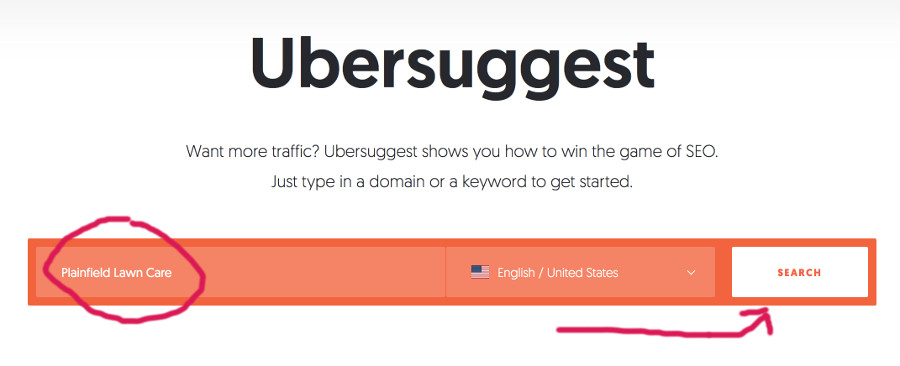
The results of your keyword search will appear on a new page. You will also get a monthly search volume graph and search volume by keyword.
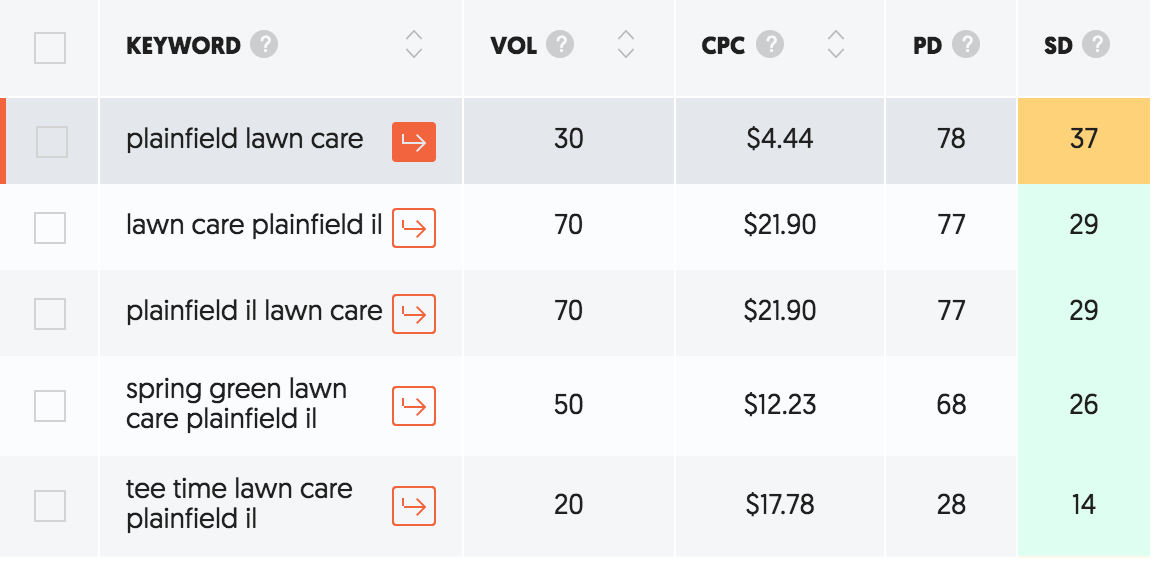
#2 Optimize Title Tag and Meta Descriptions
The title tag and meta description are tags of HTML code in the header section of every web page on your site. They tell Google, and other popular search engines the contents on the webpage. For example, when you Google something, the title tag and meta description are shown in the search engine results.
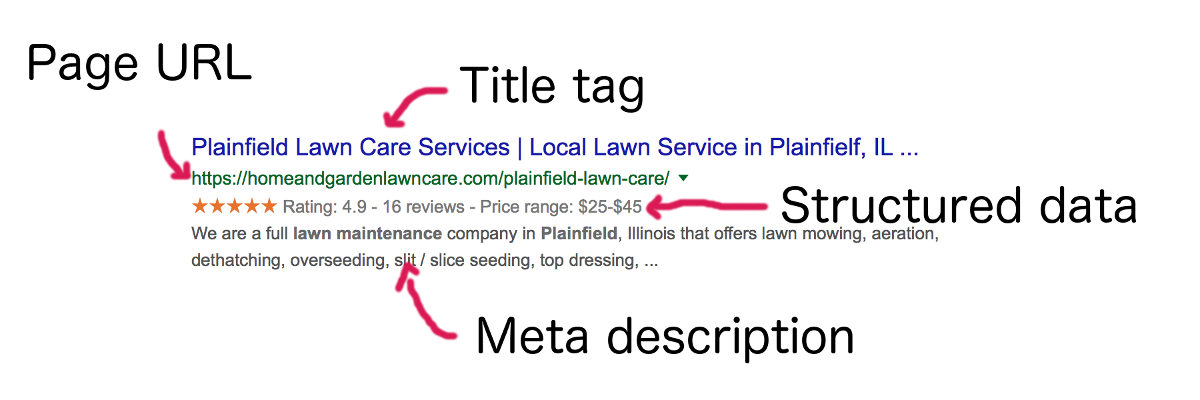
Title tag and meta description code snippet example
<!-- Title Tag -->
<title>Plainfield Lawn Care Services | Local Lawn Service in Plainfield, IL | Mowing | Aeration</title>
<!-- Meta description tag -->
<meta name="description" content="We are a full lawn maintenance company in Plainfield, Illinois that offers lawn mowing, aeration, dethatching, overseeding, slit / slice seeding, top dressing, compost, weed control, fertilizer, grub control, fungicides, hedge trimming, mulch, edging, sod and seed.">
The title tag should be around 50-60 characters long and around 160 for the meta description. Note that our keywords are relevant to the content of the page and that we have used high search volume keywords from our previous research.
Tips for writing title tags and meta descriptions
Content must be relevant to the content of the webpage, place the most important keywords at the beginning, avoid keyword stuffing and duplication, content must be engaging and feel natural.
Once you have your title and meta description tags, place them right after the <head> HTML tag of your webpage as shown in the picture below.
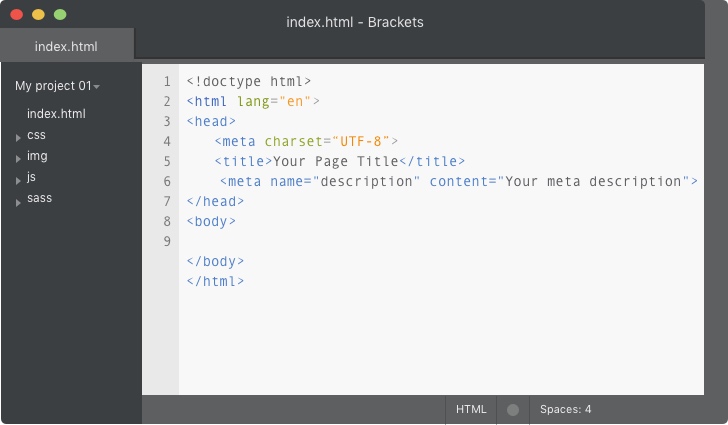
If you are using WordPress, we recommend to use a SEO plugin like Yoast, it will make optimizing your webpages very easy.
Well defined and structured title and meta tags are more likely to get more clicks from the search engine results. If implemented correctly, you will see an increase in your organic traffic.
#3 Optimize content
The process of optimizing your content is nothing more than optimizing your images, text, and code so that search engines can display it on search engine results pages (SERP’s).
Let’s take a look at a section of the “Plainfield Lawn Care” web page, as you can see, the keywords from our previous research can be found throughout the entire page.
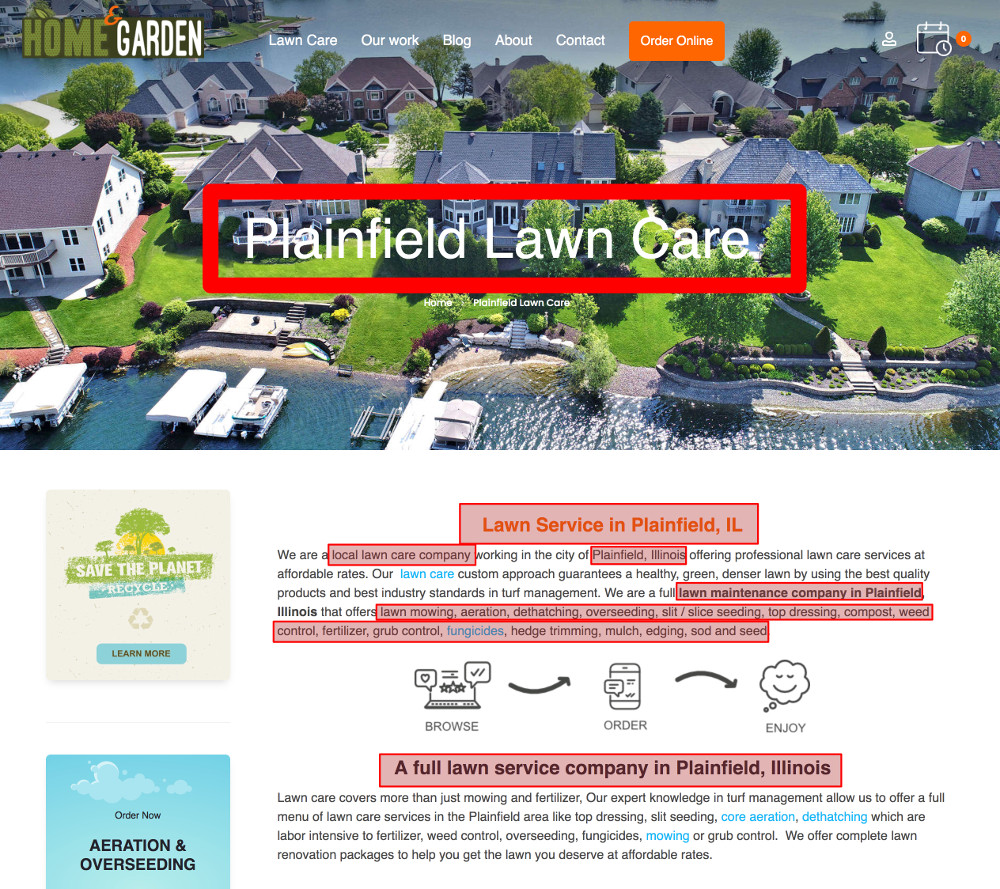
How to optimize text
Use the <h1> tag for the page content tile. Use,<h2><h3>, <h4>, and other heading tags for subtitles within your content, <p> tags for paragraphs, and make sure to use <strong>, and <em> for strong statements and emphasize information respectively.
Add the most important keywords within your content making sure to use proper keyword density, avoid keyword stuffing, and duplicate content. Make sure to write a minimum of 500 words per webpage, make it more than 1000 words if possible. The more relevant content you add, the better.
How to optimize images
Image optimization is the process of reducing the image file size as much as possible without losing quality with the purpose of keeping the website loading time relatively low (1-3 seconds). It also includes some naming techniques with the aim of increasing Google image search rankings.
Add relevant images, change the default file name to represent the image correctly. In our lawn care webpage example, the main hero image is an actual photo of a Plainfield, IL subdivision.
Make sure to use the image alt tag with relevant keywords. Check our blog post on How to optimize Images For SEO for detailed instructions.
#4 Add Structured Data
One way to tell Google about your local business is to include structured data in your web pages. Schema (schema.org) is a structured data vocabulary that defines entities, actions, and relationships on the Internet. By providing your location, address, phone number, type of services, zip codes of your service area, etc. as structured data you are one step ahead of your competition.
Google loves to crawl well organized and well-structured websites. For this reason, it is a great idea to add structured data about your company or organization. Google and other search engines use structured data to understand the content of a web page.
As a local business, your website should be optimized for search results locally, and the best way to let search engines know this is through structured data.
How to use JSON-LD to add structured data
What is JSON-LD
JSON-LD is structured data on your web page that doesn’t affect or change the current content or HTML structure. JSON-LD allows search engine crawlers to understand the information on a particular web page. Since 2015, Google announced that it would start recognizing JSON-LD as a structured data type.
We have added the structured data example below using JSON-LD for our agency which serves Chicago, IL. This code snippet is normally added right before the </body> tag. Replace the data with the information for your local business. You can get your business address coordinates from google maps as follow:
- On your computer, open Google Maps.
- Right-click the place or area on the map.
- Select What’s here?
- At the bottom, you’ll see a card with the coordinates.
#5 Add Links
Adding internal links from relevant webpages helps website navigation, defines site architecture, determines page hierarchy, and improve search engine rankings.
Tips for adding internal links
- Add links to other pages within your website if they are relevant
- Link relevant blog post to promote reading and engagement
- Keep the most important links in your main navigation
- Use the footer section for less hierarchically links
Tips for adding external links
- Add links to your social profiles like Facebook, Instagram, and Youtube
- Create your Google business listing, Bing business listing, and Yahoo small business listing
- Add your website to relevant local directories like the Yellow Pages, HomeAdvisor, and AngiesList
- Register your small business at online forums, and industry related websites
Implement the suggestions in this blog post, and you will be able to increase traffic in no time. It has worked for us and will work for you, as well.
